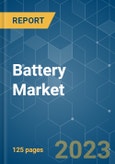The global battery market is estimated to reach a value of USD 132.44 billion by the end of this year. It is projected to register a CAGR of 16.64% during the forecast period.
The market was negatively impacted by COVID-19 in 2020. Currently, it has reached pre-pandemic levels.
This product will be delivered within 2 business days.
The market was negatively impacted by COVID-19 in 2020. Currently, it has reached pre-pandemic levels.
Key Highlights
- Over the long term, factors such as the declining lithium-ion battery prices and the growing usage of automotive batteries in electric vehicles are expected to drive the market.
- On the flip side, a mismatch in the demand and supply of raw materials for battery manufacturing is likely to hinder the market growth.
- As solar energy is an intermittent source and generates power only during the daytime, using off-grid solar power in conjunction with energy storage substantially enhances the utilization of solar PV units. As a result, energy storage with solar PV has been gaining popularity in developed countries, which is likely to create a huge opportunity for the battery market in the near future.
- Asia-Pacific is expected to dominate the battery market, with most of the demand coming from China, India, Japan, and South Korea.
Battery Market Trends
Automotive Batteries Expected to Witness Significant Growth
- Vehicles with internal combustion engine (ICE) technology were the only types preferred earlier. However, technology has now been shifting toward electric vehicles (EVs) due to growing environmental concerns. Lithium-ion batteries are predominantly used in EVs as they provide high energy density, low self-discharge, and low weight and require low maintenance.
- For ICE vehicles, lead-based batteries are being widely used. These batteries are expected to continue to be the only viable mass-market battery system for the foreseeable future. For SLI applications, lithium-ion batteries require heavy cost reductions to be considered a viable mass-market alternative to lead-based batteries.
- Lithium-ion battery systems propel plug-in hybrid and electric vehicles. These batteries contain the only available technology capable of meeting the OEM requirements for the vehicle's driving range and charging time. In 2021, the global stock of electric cars reached 16.49 million units, which increased by around 9% from 10.24 million units in 2020. This growth in EVs is expected to proped the demand for lithium-ion batteries as well.
- In January 2022, Nexeon Limited, a supplier of advanced silicon anode materials for next-generation lithium-ion batteries, licensed its NSP-1 technology to advanced material giant, SKC Co. Ltd. This contributed to the advancement of the research of automotive batteries.
- Also, in February 2022, Panasonic Corporation announced that its Energy Company will establish a production facility at its Wakayama Factory in western Japan to manufacture large cylindrical 4680 (46 mm wide and 80 mm tall) lithium-ion batteries for electric vehicles (EVs).
- Owing to the above-mentioned factors, the automotive batteries segment is expected to witness significant growth during the forecast period.
Asia-Pacific Expected to Dominate the Market
- Asia-Pacific has multiple growing economies with substantial natural and human resources. China and India are expected to be major investment hotspots for battery companies in the coming years because of policy-level support from the respective governments encouraging the manufacturing sector.
- The deployment of electric vehicles and the installation of renewable power plants in China and India are increasing rapidly, which is expected to create a massive demand for batteries.
- China is the largest market for electric vehicles (EVs), with over 1.15 million EVs sold in 2021. The country is expected to remain the world’s largest electric car market. China accounted for almost 40% of the global sales of electric cars in 2021.
- Additionally, in January 2022, the 50% ownership rule was relaxed for passenger cars in China. Also, the laws restricting a foreign company from establishing more than two joint ventures producing similar vehicles in the country were removed.
- The Government of China is expected to cut down subsidies on electric vehicles by 30% in 2022 and eliminate it by the end of the year, as the electric vehicle industry in the country is now thriving. The planned subsidy cut is aimed at reducing the reliance of manufacturers on governmental funds for the development of new technologies and vehicles.
- India is also rapidly developing advanced batteries. As part of this, in June 2022, IIT Madras researchers developed a new kind of battery technology for electric cars. They developed mechanically-rechargeable zinc-air batteries, which are more economical than the existing lithium-ion batteries and have a longer shelf life. Zinc-air batteries can be used in two-wheeler and three-wheeler EVs.
- Therefore, owing to the above developments, Asia-Pacific is likely to remain the dominant region of the battery market, supported by the increasing urbanization and consumer spending across several countries, which is expected to ramp up the demand for technically advanced devices and vehicles due to the benefits provided by the same.
Battery Market Competitor Analysis
The global battery market is fragmented in nature. Some of the major players in the market (in no particular order) include Contemporary Amperex Technology Co. Limited, BYD Co. Ltd, Duracell Inc., Tesla Inc., and Panasonic Corporation.Additional benefits of purchasing the report:
- The market estimate (ME) sheet in Excel format
- 3 months of analyst support
This product will be delivered within 2 business days.
Table of Contents
1 INTRODUCTION
4 MARKET OVERVIEW
5 MARKET SEGMENTATION
6 COMPETITIVE LANDSCAPE
Companies Mentioned (Partial List)
A selection of companies mentioned in this report includes, but is not limited to:
- BYD Co. Ltd
- Contemporary Amperex Technology Co. Limited
- Duracell Inc.
- EnerSys
- GS Yuasa Corporation
- Clarios (Formerly Johnson Controls International PLC)
- LG Chem Ltd
- Panasonic Corporation
- VARTA AG
- Samsung SDI Co. Ltd
- Tesla Inc.
- TianJin Lishen Battery Joint-Stock Co. Ltd
Methodology

LOADING...










